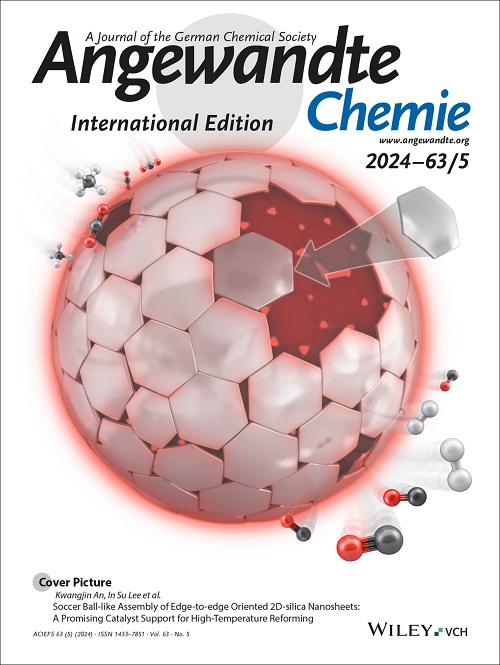Formamidinium Incorporates into Rb-based Non-perovskite Phases in Solar Cell Formulations
IF 16.1
1区 化学
Q1 CHEMISTRY, MULTIDISCIPLINARY
引用次数: 0
Abstract
Organic–inorganic hybrid perovskite materials, such as formamidinium lead iodide (FAPbI3), are among the most promising emerging photovoltaic materials. However, the spontaneous phase transition from the photoactive perovskite phase to an inactive non-perovskite phase complicates the application of FAPbI3 in solar cells. To remedy this, alkali metal cations, most often Cs+, Rb+or K+, are included during perovskite synthesis to stabilize the photoactive phase. The atomic-level mechanisms of stabilization are complex. While Cs+ dopes directly into the perovskite lattice, Rb+ does not, but instead forms an additional non-perovskite phase, and the mechanism by which Rb confers increased stability remains unclear. Here, we use 1H–87Rb double resonance NMR experiments to show that FA+ incorporates into the Rb-based non-perovskite phases (FAyRb1-yPb2Br5 and δ-FAyRb1-yPbI3) for both bromide and iodide perovskite formulations. This is demonstrated by changes in the 1H and 87Rb chemical shifts, 1H–87Rb heteronuclear correlation spectra, and 87Rb{1H} REDOR spectra. Simulation of the REDOR dephasing curves suggests up to ~60% FA+ incorporation into the inorganic Rb-based phase for the bromide system. In light of these results, we hypothesize that the substitution of FA+ into the non-perovskite phase may contribute to the greater stability conferred by Rb salts in the synthesis of FA-based perovskites.太阳能电池配方中掺入掺镱非超视晶石相的甲脒
有机-无机杂化包晶材料,如碘化甲脒铅(FAPbI3),是最有前途的新兴光伏材料之一。然而,从光活性包晶相到非活性非包晶相的自发相变使 FAPbI3 在太阳能电池中的应用变得复杂。为了解决这个问题,在包晶石合成过程中加入了碱金属阳离子,通常是 Cs+、Rb+ 或 K+,以稳定光活性相。原子层面的稳定机制非常复杂。Cs+ 直接掺入到包晶晶格中,而 Rb+ 却没有,而是形成了一个额外的非包晶相,Rb 增加稳定性的机制仍不清楚。在这里,我们利用 1H-87Rb 双共振核磁共振实验证明,在溴化物和碘化物的包晶配方中,FA+ 都会结合到基于 Rb 的非包晶相(FAyRb1-yPb2Br5 和 δ-FAyRb1-yPbI3)中。1H 和 87Rb 化学位移、1H-87Rb 异核相关光谱以及 87Rb{1H} REDOR 光谱的变化证明了这一点。REDOR 光谱。对 REDOR 去相曲线的模拟表明,在溴化物体系中,FA+ 在无机 Rb 相中的掺入率高达约 60%。根据这些结果,我们推测 FA+ 被置换到非包晶石相中可能有助于提高 Rb 盐在合成 FA 基包晶石过程中的稳定性。
本文章由计算机程序翻译,如有差异,请以英文原文为准。
求助全文
约1分钟内获得全文
求助全文
来源期刊
CiteScore
26.60
自引率
6.60%
发文量
3549
审稿时长
1.5 months
期刊介绍:
Angewandte Chemie, a journal of the German Chemical Society (GDCh), maintains a leading position among scholarly journals in general chemistry with an impressive Impact Factor of 16.6 (2022 Journal Citation Reports, Clarivate, 2023). Published weekly in a reader-friendly format, it features new articles almost every day. Established in 1887, Angewandte Chemie is a prominent chemistry journal, offering a dynamic blend of Review-type articles, Highlights, Communications, and Research Articles on a weekly basis, making it unique in the field.

 求助内容:
求助内容: 应助结果提醒方式:
应助结果提醒方式:


